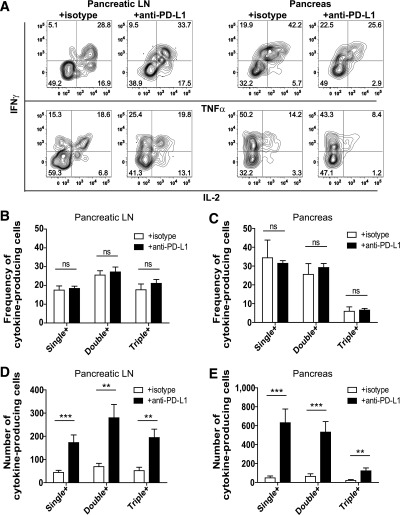FIG. 5.

Blocking PD-1 does not alter the frequency of BDC2.5 T cells programmed to produce effector cytokines but increases the absolute number of cytokine-producing cells. A: Intracellular IFN-γ, TNF-α, and IL-2 were measured in Thy1.1+ BDC2.5 T cells isolated from the pLN and pancreas after ex vivo stimulation with PMA and ionomycin. Representative flow cytometry plots are from mice harvested at day 39 posttransfer. Quantification of the frequency of cytokine-producing BDC2.5 T cells in the pLN (B) and pancreas (C). Quantification of the absolute number of cytokine-producing BDC2.5 T cells in the pLN (D) and the pancreas (E). Data shown are combined from three independent experiments conducted between days 35 and 39 posttransfer. Data in B–E represent PMA- and ionomycin-stimulated cells from 12 mice treated with isotype control and 11 mice treated with anti–PD-L1. Mice received 250 μg/injection anti–PD-L1 or isotype control antibody at days −3 and −1 prior to harvest. Analysis of single-, double-, and triple-cytokine–producing BDC2.5 cells was performed using Boolean gating. Data are representative of four independent experiments. Single +, cells that produce IFN-γ only, TNF-α only, or IL-2 only; double +, cells that produce IFN-γ and IL-2, IFN-γ and TNF-α, or TNF-α and IL-2; triple +, cells that produce IFN-γ, TNF-α, and IL-2. ns, not significant, P > 0.05. **Very significant, P = 0.001–0.01. ***Extremely significant, P < 0.001.
